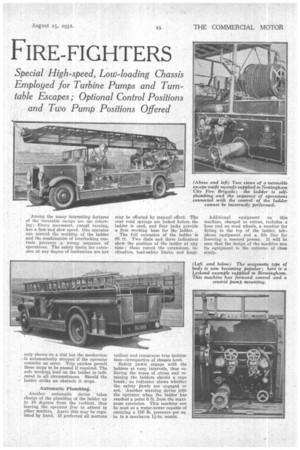LEYLAND'S LATEST FIRE-FIGHTERS
Page 44

Page 45

If you've noticed an error in this article please click here to report it so we can fix it.
Special High-speed, Low-loading Chassis Employed for Turbine Pumps and Turntable Escapes, Optional Control Positions and Two Pump Positions Offered
FOR 'many years fire-fighting appliances of Various kinds have been produced by Leyland Motors, Ltd., Leyland, Lancashire. Until recently chassis with three capacities of pump were produced, but a new design is now passing through the branch works at Chorley ; this, it is 'felt, will meet more exacting modern conditions, and four types of machine and a turntable escape outfit are now offered.
In general the four types of fire-fight ing pump have a similar specification but differ only as regards forward or normal control and mounting of the turbine amidships, with delivery to both sides, or rearward mounting with rear delivery. With the centrally located pump it is possible to employ a wagonette type of body—a pattern now becoming popular with fire brigades.
The chassis employed for these machines is similar to the well-known Leyland passenger models but has a shorter wheelbase (12 ft. 3 ins.) ; it is propelled by a six-cylindered, overhead-camshaft engine developing 72.7 b.h.p. at 1.000 r.p.m. It is three-point mounted in the chassis to avoid the effects due to frame distortion when the pump is on rough ground.
Two separate ignition systems are provided, there being two sets of plugs; an electric starter is standard equipment. In addition to the normal controls additional levers are provided ndjocent to the turbine pump. A hypass and self-cleaning filter in the engine-cooling system permit water from the main pump to be employed to give the requisite additional cooling during long pumping periods.
Incorporated in the four-forwardspeed, unit-mounted gearbox is a takeoff, with control effected from the driver's compartment. A single-piece propeller shaft drives the underslung worm-type rear axle, the ratio being 5.5 to 1 and permitting a maximum road speed of about 50 m.p.h. Fourwheel brakes, with a 'Dewandre servo motor, comprise the service set, whilst the hand brake consists of separate shoes in the rear-wheel drums.
The pump employed is the latest type of Rees-Roturbo two-stage selfpriming turbine; it is built throughout of gunmetal with the exception of the main spindle which is in stainless steel suitably sheathed in gunmetal. It is rated as of 400-700 gallons-per-minute capacity. When the lift is so great as 25 ft. it takes only 18 secs. to prime the pump, which runs at 1.53 engine speed.
A single suction inlet and four delivery outlets are standardized. The first-aid equipment comprises a small auxiliary pump, 180 ft. of hose on a reel and a 40-gallon brass tank. The control valves and connections permit the set to be used in various ways.
The Turntable Escape.
For the turntable escape the chassis has a wheelbase of 14 ft. 6 ins, and normal control is provided. The engine in this case is of slightly smaller capacity, having an output of 62 b.h.p. at 1,000 r.p.m. The design, • of course, follows usual Leyland practice in that the valves are located ov,erhead, being operated by a chain-and-gear-driven camshaft All the valve seats are of centrifugally cast iron inserted in the detachable cylinder head. The six cylinders are cast monobloc and have centrifugally cast sleeves.
In general, the chassis employed for this machine follows the lines of that specified for the pump. The power take-off on the gearbox provides the drive for the various motions of the extending ladder. Two tubular shafts, with a reduction gearbox interposed, convey the drive to the base of the ladder, which is built to Metz specifications. A rotary oil pump provides the operating medium for hydraulic clutches which regulate the various motions of the ladder. Among the many interesting features of the turntable escape are the following: Every movement, except turning, has a fast and slow speed. One operator can control the working of the ladder and the combination of interlocking controls prevents a wrong sequence of operations. The safety limits for extension at any degree of inclination are not
only shown on a dial but the mechanism is automatically stopped if the operator commits an error. Trip catches permit these stops to be passed if required. The safe working load on the ladder, is indicated in all circumstances. Should the ladder strike an obstacle it stops.
Automatic Plumbing.
Another automatic device takes charge of the plumbing of the ladder up to 10 degrees from the vertical, thus leaving the operator free to attend to other matters. Again this may be regulated by band. If preferred all motions may be effected by manual effort. The rear road springs are locked before the ladder is used, and four jacks provide a firm working base for the ladder.
The full extension of the ladder is 85 ft. Two dials and three indicators show the position of the ladder at any, time ; these record the extensions, inclination, load-safety limits, and longi
tudinal and transverse true inclination—irrespective of chassis level.
Safety pawls engage with the ladders at rung intervals, thus relieving the ropes of stress and retaining the ladders should a rope break ; an indicator shows whether the safety ilawls are engaged or not. Another warning device tells the operator when the ladder has reached a point 6 ft. from the maximum extension. This machine can be used as a water-tower capable of carrying a 150 lb. pressure per sq. in. to a maximum 11-in. nozzle. Additional equipment on this machine, charged as extras, includes a hose reel on road wheels, a monitor for fitting to the top of the ladder, telephone equipment and a life line for lowering a rescued person. It will be seen that the design of the machine ant its equipment is the outcome of close study.




























































































